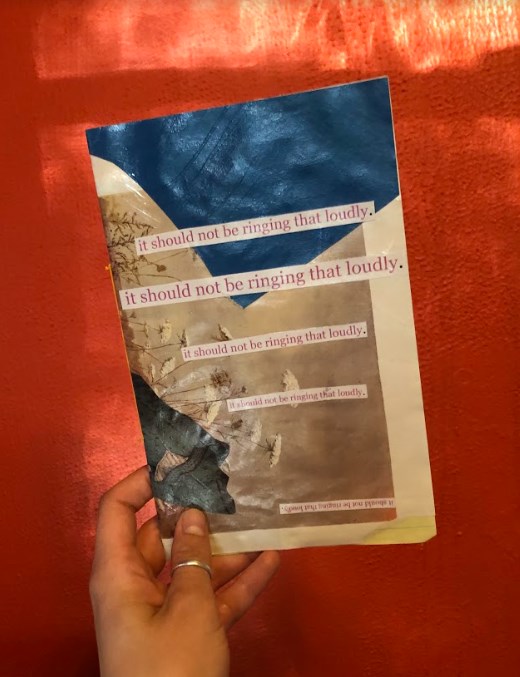Every time someone asks me this question, I find myself tripping over my words to try and arrange a coherent answer.
While there is no singular definition of a zine, I like to think of zines as small book-like or magazine-like containers for expression of all kinds. Terms like DIY, self-published, non-commercial, easily reproduced, small batch, and hyper-local are often descriptors of a zine and many zines are hand folded or bound.
Zines can be made in large batches or be one of a kind. Some are sold and others are handed out for free or traded. Some zines are submission-based and others are made by one person. Zines can include writing, photographs, artwork, poetry, collage, and more.
Zines are an outlet for self expression and artistic passion as well as a form of insider communication and a way to critique capitalistic and elitist systems within the hierarchical world of mainstream media. Their DIY nature makes zines a relatively accessible form of artistic and personal expression–all it takes to create one is a single piece of paper and a pen or pencil. Add a photocopier and that zine can reach the hands of many many people, all without relying on formal publishing networks.
As The Bindery puts it, zines are “a glorious mash-up of art, letters, story and emotion; just like the brains, hands and hearts of those who produce them.”
Still confused? Me too!
Maybe parsing apart a definition of a zine is a fool’s errand, but historical context helps crystalize the timeless power of zines.
A brief history zines in the United States:
- The term “zine” was first utilized in the 1930s and 40s by fans of science fiction writing. These superfans created “fan magazines” to connect with other fans and share their writing, analyses, and artwork. The term “fan magazine” was shortened to “fanzine” and then again to “zine.”
- Zine culture grew significantly alongside the DIY punk music scene of the 1970s and 80s. Zines were often cheaply distributed or traded and they traveled with touring bands all across the country. DIY punk culture was highly informed and motivated by a pushback against mainstream corporate elitism and zines from this era included writings and art that echoed that anger towards capitalism, sexism, racism, and more. Punk zines “represented the aesthetic and ideals of an entire subculture, a condensed version of this cultural revolt against authoritarianism.”
- Just as with any other movement, the punk movement is not without flaws and has been critiqued for its overwhelmingly white middle class representation. Pushback against that emerged in the form of subcultures within the movement that aimed to elevate the experiences of marginalized groups within the punk scene, and one of the ways that those movements grew was through the distribution of zines. For example, Queercore was a subculture that critiqued homophobia in the punk spaces as well as more widely in cultural and movement spaces. Queercore zines were one of the main forms used to spread the ideas and beliefs of the movement. riot grrrl brought attention to the overwhelming dominance of white male influence in punk spaces. riot grrrl zines spread feminist ideologies and shared artists, musicians, and fans’ personal experiences of sexism in the music industry. Both of these movements used zines to encourage discussion and share experiences about topics that would be considered taboo or risque in other publishing contexts.
- A more recent theme in contemporary zine making is prisoners rights. In these zines, compilations of political essays, works by scholars and activists, and writings by people who are incarcerated critique the prison industrial complex and make accessible theories and writings of prison abolition and broader radical social change that are often gatekept within the academic world.
Zines are for everyone.
There is no way to make one, and there is no right or wrong thing to make one about. They can be hyperpersonal or broadly relatable. They can fit in the palm of your hand or take up an entire table. They can fold like a book or unravel like an accordion.
Making zines can be an act of resistance and an act of love. They can also be a slow Saturday morning activity with a few friends or a Tuesday night alone with some music or a T.V show. Zines can be created in order to spread far and wide, or shared with one or two people, or with nobody at all.
For me, zines are a way to release something that I am holding–not necessarily release it forever, and not necessarily in a way that fixes or solves something. They are a way to take something in my heart or head and hold it in my hands.
They can help me unravel grief, and visualize love, and arrange something when so much of the world around me is out of my control. They can also be about absolutely nothing. When I sit down to create a zine, they include not only the pages that I end up with, but all of the emotions and interactions that went into creating it, which is why I particularly love creating in community with others.
Sometimes they take weeks and months to write and arrange, but more often, the one-page zines that I create emerge from just one sitting and a burst of silly creative energy. Zines don’t have to be sold or distributed, and most of mine end up somewhere on my desk.
You don’t need to consider yourself an artist or a writer to make a zine. All you need is to sit down and do it.
So, how can you start your zine collection?
- Zinefests are gatherings of zinesters (zine-makers) and artists and a beautiful space to sell and collect zines as well as meet other artists and zine-lovers. (Check out the Twin Cities Zine fest!)
- Zines are also often found in independent and radical bookstores like Boneshaker and Moon Palace which are both located in Minneapolis.
- There are also extensive online archives of zines.
- Zine Workshops at Sentier Psychotherapy
Want to try it yourself?
Like zines themselves, the zine shops that I facilitate at Sentier Psychotherapy are also for anyone and everyone. For those that are new to zine-making, there will be a demonstration of one of the simplest and most popular zine making techniques, one that uses one sheet of paper with four folds and one cut–that’s it!
Each workshop has a theme but these are loose and all participants are welcome to create whatever they feel. Sentier will provide all of the supplies–books, magazines, paper, glue, etc.– so that participants can collage mini-zines.
Come ready to write, collage, and create in community about whatever is calling to you and see what emerges. To read more about the upcoming workshops, visit Sentier’s website. If you have questions or would like to register, please email [email protected].
The cost of the workshop, including all materials, is $25 with sliding scale fees available. Sentier Psychotherapy is located in St. Paul and the room where workshops are held is located up one flight of steps.
Please note that these workshops are artist led and not therapy groups.
Blog written by Client Care Coordinator Ellie Struewing. Go to eleanorstruewing.com to see more of Ellie’s artwork, including their zines.













